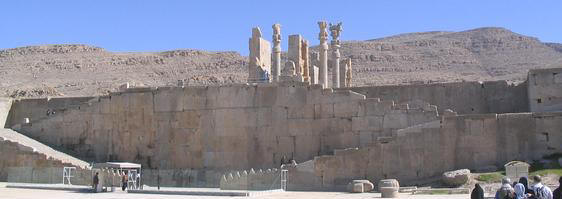
Contents
Persepolis
Page 1
Building of Persepolis
Page 2
Gate & Hall
Page 3
Palace
Page 4
Destruction by Alexander
Page 5
Videos
Page 2
Stairway to the Gate of All Nations & Xerxes' Inscription
» Page 1: Building of Persepolis
» Page 3: Palace
» Page 4: Destruction

Stairway to the Gate of All Nations as seen today

Stairway to the Gate of All Nations - artist's reconstruction
Source: Persepolis3d.com. K. Afhami and W. Gambke
Visitors to Persepolis first ascended a 14-meter-high double stairway that lead to the Gate of Nations, also called the Gate of Xerxes. The gate contains a trilingual cuneiform stone inscription in Persian, Babylonian and Elamite (shown below) on the gate authored by King Xerxes.

King Xerxes' inscription carved into the Gate of All Nations
The stone inscription reads:
"Great is Ahura Mazda, God, who created this Earth, who created the heavens, who created humanity, who created happiness for humanity, who made Xerxes King, one King of many, one Lord of many. I am Xerxes, Great King, King of Kings, King of lands, King of many peoples, King of this land far and wide, son of Dariush the King, the Achaemenian. King Xerxes says: By the grace of Ahura Mazda I constructed this Gateway of All Nations. Many other beautiful things were constructed in Persia. I constructed them and my father constructed them. Everything we have constructed which looks beautiful we have constructed by the grace of Ahura Mazda. King Xerxes says: May Ahura Mazda protect me and my kingdom and whatever is constructed by me as well as what has been constructed by my father."
» Top
Gate of All Nations

Gate of All Nations as seen today

Gate of All Nations - artist's reconstruction
Source: Persepolis3d.com. K. Afhami and W. Gambke
Two massive stone bulls guarded the outer doorway and two winged human-headed bulls guarded the opposite, inner doorway.
All visitors entered through this gate which had three doorways leading to different areas of the complex. The doorway was used as an entrance only. Nobles left the complex through a southern doorway facing the Apadana palace, while other delegations left through the eastern gate that faces the mountain.
The Interior of the Gate of all Nations had a soaring ceiling supported by four columns and three doorways. The capitals that capped the columns were stylized representations of hanging date palm leaves. The columns represented the trunks of the palms.
The Apadana or Audience Hall

The Apadana Ruins

Apadana as seen from the outside walls with the Gate of All Nations in the background
Artist's reconstruction
Source: Persepolis3d.com. K. Afhami and W. Gambke
The Apadana was the audience hall where the King received delegations.
It is an architectural wonder of the ancient world - its clever construction enabled dimensions without comparison in its time. The ceiling was supported by 36 stone columns, each 20m (60.5') high. They were the tallest and thinnest that architects had mastered in that era.
» Page 1: Building of Persepolis
» Page 3: Palace
» Page 4: Destruction